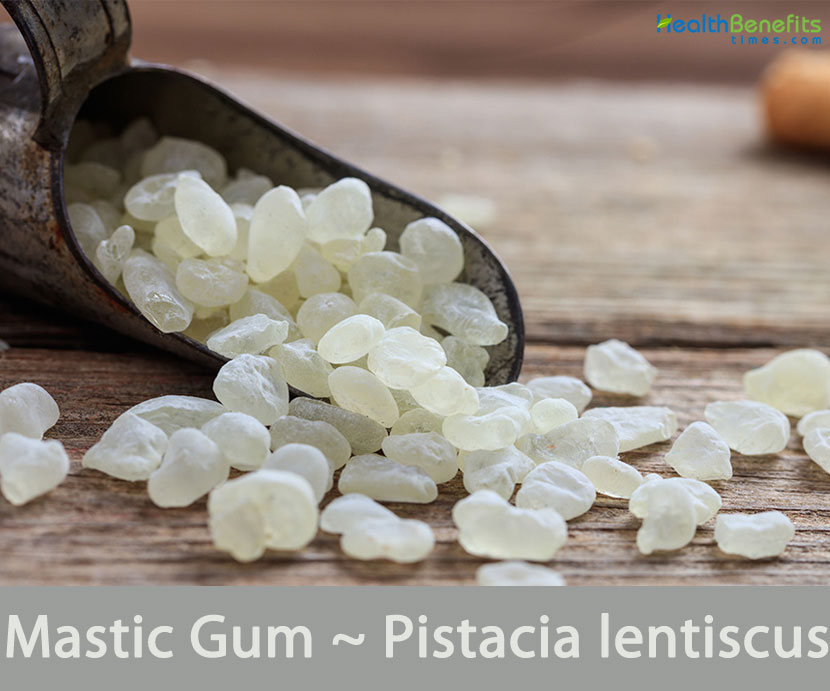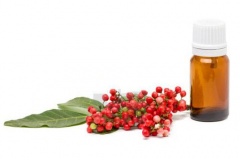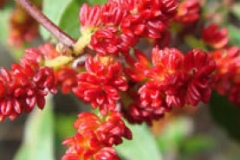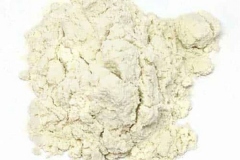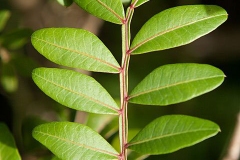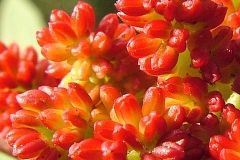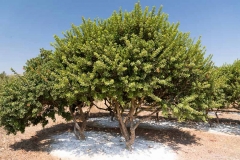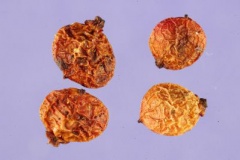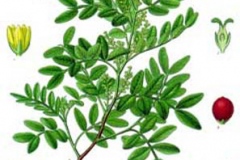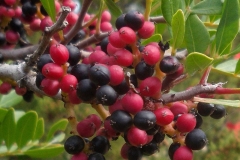The word mastic is derived from the Latin word Masticare (to chew), in Greek: μαστιχάω verb mastichein (to gnash the teeth, the English word completely from the Latin masticate) or massein. The essential oil obtained from the gum/resin is commonly called mastic oil, whereas the oil obtained from the leaves is termed lentisk oil. Mastic, foliage, and fruit essential oils have served in traditional human medicine for millennia. In human medicine, aqueous extracts of leaves and young twigs are prepared as infusions or decoctions. Leaves and young twigs are used “as is” in veterinary medicine.
Mastic Gum Facts
| Mastic gum Quick Facts | |
|---|---|
| Name: | Mastic gum |
| Scientific Name: | Pistacia lentiscus |
| Origin | Throughout the Mediterranean region |
| Colors | Initially green then red, and finally black as they mature |
| Shapes | Globose drupe, 4-7 mm in diameter |
| Taste | Bitter, sweet, Astringent |
| Health benefits | Relieve digestive issues, Ease inflammatory bowel disease, Reduce Cholesterol, Overall liver health, Combat Dental Plaque, Bad Breath (Halitosis), Treat allergic asthma, Prevent prostate cancer, Prevent colon cancer, Heartburn & Indigestion, GERD, Peptic & Duodenal Ulcer, Functional Dyspepsia |
| Name | Mastic Gum |
|---|---|
| Scientific Name | Pistacia lentiscus |
| Native | Throughout the Mediterranean region, from Morocco and the Iberian peninsula in the west through southern France and Turkey to Iraq and Iran in the east. It is also native to the Canary Islands |
| Common Names | Chios mastic tree, Lentisc, Mastic, Mastic tree, Mediterranean mastic tree, lentiscus, lentisk, masticshrub |
| Name in Other Languages | Albanian: Bafër, xinë Arabic: Mastakiun (مصطكي), mustik, batm allaantik (بطم اللانتيك) Armenian: Pistakeni iskakan (Պիստակենի իսկական) Azerbaijani: Mastika püstəsi Basque: Legeltxor Bulgarian: Mastikovo dŭrvo (мастиково дърво) Catalan: Llentiscle, mata Chinese: Rǔxiāng huánglián mù (乳香黃連木) Corsican: Listincu Croatian: Tršlja Czech: Rečík lentišek Danish: Mastixbusk, Mastikstræ, Mastixtræ Divehi: Mastakā (މަސްތަކާ) Dutch: Mastikboom, Mastiekboom English: Chios mastic tree, Lentisc, Mastic, Mastic tree, Mediterranean mastic tree, lentiscus, lentisk, masticshrub Esperanto: Lentisko Finnish: Mastiksipistaasi French: Arbre à mastic, Arbre au mastic, Lentisque, Lentisque d’Espagne, Lentisque pistachier , Pistachier lentisque, restring Galician: Lentisco German: Mastixbaum, Mastixpistazie, Mastrix-Strauch, Mastix-Baum, Mastix- Pistazienstrauch, Mastix-Pistazie Greek: Schíno (σχίνο), Mastícha (Μαστίχα), mastichódentro (μαστιχόδεντρο) Hebrew: Elat hammastik, als hmstik (אֵלַת הַמַּסְטִיק) Hungarian: Masztix, Örökzöld pistácia Ido: Lentisko Italian: Lentisco, Lentischio, Sondrio, corno-capra, dentischio, sondro, stinco Japanese: Masutikusu (マスティクス) Kabyle: Imidek Korean: Maeseutignamu (매스틱나무) Kurdish: Benîştok Lithuanian: Mastika Manx: Billey masthag Netherlands: Mastikboom Norwegian: Mastik Persian: مصطکی (درخت) Portuguese: Almecegueira, Almestigueiro, Almestigueira, Aroreira, Lentisco, Lentisco-verdadeiro, alfostigueiro, aroeira-da-praia, almessigeira, aroeira, darmacho, daro, daroeira, moita-do-dro, árvore-do-mástique, terebinto Polish: Pistacja kleista Russian: mastikovoye derevo (мастиковое дерево), fistashka mastikovaya (фисташка мастиковая), fistaška mastičnaâ (фисташка мастичная) Sardinian: Chessa Serbian: Tršlja Shambala: Tršlja Slovenian: Trälja, Vazdazelena pistacija Spanish: Alfócigo, Alfóncigo, Alfóstigo, Árbol de la almaciga, Arbol de la almáciga, Llentisclars, Lentisco, Pistachero-alfoncigo, Mastika, almástiga, entina, mata dentisca, mata charneca Swedish: Mastixbuske Thai: Phis̄ tā chī xo p̀ā (พิสตาชีโอป่า) Tunisian Arabic: ضرو Turkish: Sakız ağacı Upper Sorbian: Mastiks |
| Plant Growth Habit | Dioecious, resinous, evergreen, aromatic shrub or small tree |
| Growing Climates | Woodlands, dehesas (almost deforested pasture areas), Kermes oak woods, wooded areas dominated by other oaks, garrigues, maquis shrublands, hills, gorges, canyons, and rocky hillsides of the entire Mediterranean area |
| Soil | Grows on all types of soils, and can grow well in limestone areas and even in salty or saline environments, making it more abundant near the sea |
| Plant Size | Up to 4 m (13 ft) tall. In many open spaces it attains a height of up to 7 m. |
| Resin | Transparent, lemon-white colored, tear-shaped natural resin |
| Bark | Mature bark is greyish, but on the branches and young trees it is greenish or reddish in color |
| Leaf | Arranged alternately on the branches, while the leaflets are more or less opposite along the leaf stalk, which often has small lateral wing-like expansions |
| Flowering season | Mid-March and the end of April |
| Flower | Male flower has 1-2 perianth lobes and 3-5 separate stamens, whose filaments are short and red. The male flowers grow as a sorus, and produce a large amount of pollen grains. The female flower has 2 bracteoles, 2-5 perianth loves. |
| Fruit Shape & Size | Globose drupe, about 4-7 mm in diameter |
| Fruit Color | Initially green then red, and finally black as they mature |
| Flavor/Aroma | Strong, slightly smoky, resiny aroma |
| Taste | Bitter, sweet, Astringent |
| Plant Parts Used | Gum Resin, Galls |
| Season | October |
| Health Benefits |
|
Plant Description
Mastic tree is a dioecious, resinous, evergreen, aromatic shrub or small tree that normally grows up to 4 m (13 ft.) tall. In many open spaces it attains a height of up to 7 m. The plant is found growing in woodlands, dehesas (almost deforested pasture areas), Kermes oak woods, wooded areas dominated by other oaks, garrigues, maquis shrub lands, hills, gorges, canyons, and rocky hillsides of the entire Mediterranean area. The plant grows on all types of soils, and can grow well in limestone areas and even in salty or saline environments, making it more abundant near the sea. The mature bark of the tree is greyish, but on the branches and young trees it is greenish or reddish in color.
Resin
The aromatic, ivory-colored resin, also known as mastic, is collected as a spice from the cultivated mastic trees grown in the south of the Greek island of Chios in the Aegean Sea, where it is also known by the name “Chios tears”. It occurs in roundish tears about the size of a small pea, or in flattened, irregular pear-shaped, or oblong pieces covered with a whitish powder. They are pale yellow in color, which darkens with age. Originally liquid, it is hardened, when the weather turns cold, into drops or patties of hard, brittle, translucent resin. When chewed, the resin softens and becomes a bright white and opaque gum. The odor is agreeable and the taste is bitter at first, but after some chewing, it releases a refreshing flavor similar to pine and cedar.
Leaves
The leaves are persistent, leathery, hairless, and composed of 2-7 pairs of leaflets (even-pinnate), unlike its relative, the Mount Atlas mastic (Pistacia altantica), which has an uneven number of deciduous leaflets. They are 1.5-3 cm long. The leaves are arranged alternately on the branches, while the leaflets are more or less opposite along the leaf stalk, which often has small lateral wing-like expansions. The leaflets also have an entire margin, are elliptical or lanceolate, shiny, dark on the upper side, somewhat lighter on the underside and, often, terminate in a soft tip. The leaves are often damaged by round galls that protrude from the leaf surface. The leaf axis is flat and winged.
Flower
Pistacia lentiscus blooms in between Mid-March and the end of April. The flowers are single-sex and arranged as a panicle-like inflorescence. The shrub is dioecious, and male and female flowers do not grow together on the same individual. The male flower has 1-2 perianth lobes and 3-5 separate stamens, whose filaments are short and red. The male flowers grow as a sorus, and produce a large amount of pollen grains. The female flower has 2 bracteoles, 2-5 perianth loves. The style is short; the stigma at its tip is divided into 3 lobes. The ovary is superior. The tree is pollinated by wind.
Fruit
Fertile flowers are followed by globose drupe, 4-7 mm in diameter, and not very fleshy. The fruits are arranged in limp racemes. The single fruit resembles a drupe, and contains a single seed. The fruit is green at first, then red, and the ripe fruit is black. Seeds are dispersed by birds.
Health benefits of Mastic Gum
Listed below are some of the well-known health benefits of using Mastic Gum
1. Relieve digestive issues
Mastic gum can be used to relieve abdominal discomfort, pain, and inflammation due to the antioxidants and anti-inflammatory compounds it contains. Further research is required to learn more about the exact mechanisms in which mastic gum works.
It is useful in treating common digestive complaints like indigestion and acid reflux. The act of chewing any gum helps stimulate saliva production, which in turn helps reduce the acidity of the stomach. This, in combination with the anti-inflammatory properties of mastic, may calm the stomach and reduce the buildup of acid.
Take 250 mg of mastic gum capsules 4 times per day. You can also add 2 drops of mastic gum oil to 50 milliliters (mL) of water to make a mouthwash. Don’t swallow the liquid.
2. Ease inflammatory bowel disease
Research suggests that mastic gum may help ease the symptoms of Crohn’s disease, which is a common form of IBD. In a research, people who took mastic gum for four weeks experienced a significant decrease in the severity of their inflammatory symptoms. Researchers also found decreased levels of IL-6 and C-reactive protein, which are markers of inflammation. More research is needed to understand the exact mechanisms in which mastic gum works.
3. Reduce Cholesterol
Recent research suggested that mastic could be used to reduce cholesterol levels and improve cardiovascular health. People who consumed mastic gum for a total of eight weeks reported reduced cholesterol and blood sugar levels, with more notable reductions in overweight subjects.
They reported that there were no “detectable side effects” and suggested that mastic gum could be used to reduce high cholesterol and blood sugar in overweight/obese persons, as well as to control blood sugar and cholesterol in otherwise healthy individuals.
4. Overall liver health
Mastic gum may help prevent liver damage. In a research participants who took 5 g of mastic gum powder for 18 months experienced lower levels of liver enzymes related to liver damage than participants who did not. One recent study found it effective for protecting the liver while used as an anti-inflammatory in mice.
5. Combat Dental Plaque
Chewing Mastic gum is more effective for reducing oral plaque. Research concluded that subjects who chewed mastic gum had considerably less plaque than the control group, suggesting that it could be used to promote oral health and decrease the risk of periodontal disease.
Mastic gum is highly effective in reducing oral bacteria by more than 40%. To experience these benefits the mastic needs to be chewed, as mastication releases the antibacterial compounds, working to eradicate bacteria in the mouth much like a mouthwash would.
6. Bad Breath (Halitosis)
Mastic gum is considered an effective treatment for bad breath. Chewing mastic gum helps freshening up the breath and removes bad mouth odor.
The antimicrobial action of Mastic gum reduces microbes in the mouth responsible for bad breath. Most bacteria grow in the mouth due to the breakdown of food particles in the mouth. This reaction produces foul odor in the mouth.
7. Treat allergic asthma
Mastic gum has anti-inflammatory properties that may make it beneficial in treating allergic asthma. This type of asthma often includes airway inflammation, eosinophilia, and airway hyper-responsiveness. It had a positive effect on lung fluid and lung inflammation. In vitro tests found that mastic gum inhibited cells that react negatively to allergens and cause airway inflammation. Although these results are encouraging, further research is needed to conclude efficacy in human cases.
8. Prevent prostate cancer
Researchers are investigating mastic gum’s role in inhibiting prostate cancer development. Mastic gum can inhibit an androgen receptor that may have an effect on the development of prostate cancer. Mastic gum was shown to weaken the expression and function of the androgen receptor in prostate cancer cells. Human studies are required to confirm and expand upon these findings.
9. Prevent colon cancer
Research suggests that mastic essential oil may also help suppress tumors that can lead to colon cancer. Researchers found that mastic oil inhibited the increase of colon cells in vitro. When given orally to mice, it inhibited the growth of colon carcinoma tumors. Further study is needed to expand upon these findings.
10. Heartburn & Indigestion
Mastic gum appears to reduce the gastric acid in the stomach. Generally, 500 mg mastic gum is used with 1000 mg licorice powder to get instant relief from the heartburn.
In Ayurveda, mastic gum, licorice, Amla and Praval Pishti and Mukta Pishti are added to increase the effectiveness of the Heartburn and Indigestion treatment. 2 to 4 weeks therapy with this combination cures indigestion (dyspepsia) and heartburn.
11. GERD
Gastro-esophageal Reflux (GERD) is actually caused by the weakness of the lower esophageal sphincter valve, which cause acid reflux. Mastic gum is very useful for providing strength to the valves. Further, it also has antacid action, which reduces symptoms of GERD.
12. Peptic & Duodenal Ulcer
Mastic gum powder fights off Helicobacter Pylori, ulcer-causing bacteria. It has potential inhibiting and bacteriolytic action against H. Pylori. Recent studies have shown Mastic gum effectiveness in stomach as well as intestinal ulcers.
Mastic gum is also effective in other causes of ulcer, which may include use of NSAIDs and other medicines that may result in erosion of gastric or intestinal mucosa. Mastic gum builds a protective layer on linings of stomach and intestines, which prevents and treats ulcers.
13. Functional Dyspepsia
Dyspepsia is the uncomfortable feeling or pain in the upper-middle part of your stomach. It is usually accompanied by bloating, heartburn, nausea, vomiting, and burning stomach ache.
In various studies, hydrogen receptor antagonists and proton-pump inhibitors did not improve dyspepsia. Herbal remedies like Iberogast and artichoke leaf extract showed promising results. Mastic gum is a well-known herbal alternative that can treat this condition.
Almost 25% of its total weight is a polymer. In an acid environment, this becomes a runny resin, which could have gastric cell-protectant effects in patients. The gum has triterpenoid acids that could have antimicrobial and antioxidant effects on these cells. Dyspepsia patients treated with mastic gum showed double the improvement in the placebo group.
Traditional uses and benefits of Mastic gum
- It is used in modern herbalism though it could be used as an expectorant for bronchial troubles and coughs and as a treatment for diarrhea.
- Resin is analgesic, antitussive, carminative, diuretic, expectorant, odontalgic, sedative and stimulant.
- It is mixed with other substances and used as a temporary filling for carious teeth.
- Internally it is used in the treatment of diarrhea in children.
- Externally it is applied to boils, ulcers, ringworm and muscular stiffness.
- It is used for treatment of high cholesterol, Crohn disease, diabetes, and hypertension.
- In the East it is still used medicinally in the diarrhea of children and masticated to sweeten the breath.
- People in the Mediterranean region have used mastic as a medicine for gastrointestinal ailments for several thousand years.
- Mastic oil has antibacterial and antifungal properties, and as such is widely used in the preparation of ointments for skin disorders and afflictions.
- It is also used in the manufacture of plasters.
- It is a powerful aphrodisiac herb which is powerful in increasing libido.
- It is a good herbal remedy for healing wounds and cuts.
- It supports liver functions and strengthens them to prevent Liver diseases.
- It protects your digestive tract from the ailments that causes Peptic Ulcers.
- It also decreases swelling of the patients debilitated with Crohn’s Disease.
- It is superior in regulating the Colon and the Intestines functions that reduces the risk of Irritable Bowel Syndrome.
- It lessens Teething Problems.
- It is used to lower the High Blood Pressure.
- It is a good digestive herb which strengthens the digestive tract and hinders the risk of Indigestion.
- It is used to alleviate Stomach Pain. It also reduces the Abdominal Diseases and associated symptoms.
- The resin of this herb is a beneficial remedy to fight against Cancer.
- It also immunes the body from Infections.
- It reduces the cholesterol levels of the patient suffering with High Cholesterol.
- It is used to kill insects.
- It is effective in the treatment of diabetes.
- It has anti-asthmatic properties that are favorable in aiding asthma.
- It stops muscle aches.
- It guards the body against Bacterial and Fungal Infections.
- It has the ability to improve the blood circulation.
- It lowers the risk of getting Heart Attack.
Culinary Uses
- Sweet licorice-flavored resin, called ‘mastic’, is obtained from incisions made into the bark of the trunk, but not into the wood.
- It is chewed to strengthen the gums and as a breath sweetener and also used as a flavoring in puddings, sweets (including ‘Turkish delight’) cakes etc.
- It is also the basis of a Greek confectionery called ‘masticha’ and a liqueur called ‘mastiche’.
- Edible oil is obtained from the seed.
- In Lebanon and Egypt, the spice is used to flavor many dishes, ranging from soups to meats to desserts.
- In Morocco, smoke from the resin is used to flavor water.
- It is also used to stabilize loukoumi and ice cream.
Other Facts
- The resin ‘mastic’ is obtained by making incisions in the bark (not the trunk) of the tree from mid-summer to the autumn.
- It can be dried and used as a powder, or distilled for oil and essence.
- It is used in high grade varnishes, as a fixative in perfumes, tooth pastes, glue (especially for false beards), embalming, a temporary filling for teeth etc.
- It is used to seal the edges of microscope mounts and is also chewed to preserve the teeth and gums.
- An oil obtained from the seed is used for lighting, soap making etc.
- Mastic resin is a relatively expensive kind of spice; it has been used principally as a chewing gum for at least 2,400 years.
- Mastic gum is also used in the production of high-grade varnish.
- Mastic varnish was used to protect and preserve photographic negatives.
- Mastic is also used in perfumes, cosmetics, soap, body oils, and body lotion.
- In ancient Egypt, mastic was used in embalming.
- It is also extensively used in soap, cosmetics, toothpaste, varnish, paint, and cream-making.
Precautions
- Small risk of diarrhea in children.
- Avoid oral intake of essential oil.
- In some cases, it may cause headache, upset stomach, and dizziness.
- Allergic reactions are also possible, especially in people who have an allergy to the flowering plant Schinus terebinthifolius or other Pistacia species.
- You shouldn’t take mastic gum if you’re pregnant or breastfeeding.
References:
https://www.itis.gov/servlet/SingleRpt/SingleRpt?search_topic=TSN&search_value=506468#null
https://npgsweb.ars-grin.gov/gringlobal/taxon/taxonomydetail?id=28647
https://pfaf.org/user/Plant.aspx?LatinName=Pistacia+lentiscus
https://www.drugs.com/npp/mastic.html
https://www.botanical.com/botanical/mgmh/m/mastic23.html
https://en.wikipedia.org/wiki/Pistacia_lentiscus
https://www.cabi.org/isc/datasheet/41027
https://davesgarden.com/guides/pf/go/100618/#b
https://gd.eppo.int/taxon/PIALE
http://www.theplantlist.org/tpl/record/kew-2407564
https://en.wikipedia.org/wiki/Mastic_(plant_resin)


